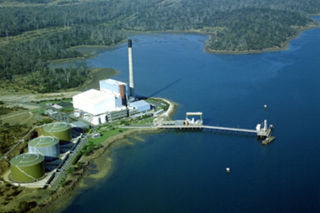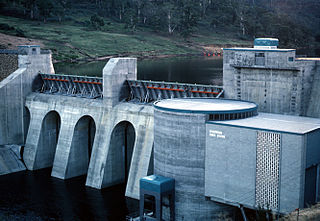
Lake Gordon is a man-made reservoir created by the Gordon Dam, located on the upper reaches of the Gordon River in the south-west region of Tasmania, Australia.

Hydro Tasmania, known for most of its history as the Hydro-Electric Commission (HEC) or The Hydro, is the trading name of the Hydro-Electric Corporation, a Tasmanian Government business enterprise which is the predominant electricity generator in the state of Tasmania, Australia. The Hydro was originally oriented towards hydro-electricity, due to Tasmania's dramatic topography and relatively high rainfall in the central and western parts of the state. Today Hydro Tasmania operates thirty hydro-electric and one gas power station, and is a joint owner in three wind farms.

Transend Networks Pty Ltd was a Tasmanian government-owned business which operated between 1998 and 2014 as the electricity transmission network provider for Tasmania, Australia. It was formed by the disaggregation of the Hydro-Electric Commission, and ceased operation when it was merged on 1 July 2014 with the distribution division of Aurora Energy to form the combined network business TasNetworks.

Douglas Ackley Lowe AM was the 35th Premier of Tasmania, from 1 December 1977 to 11 November 1981. His time as Premier coincided with controversy over a proposal to build a dam on Tasmania's Gordon River, which would have flooded parts of the Franklin River. The ensuing crisis saw Lowe overthrown as Premier and resign from the Labor Party, acting as an independent for the remainder of his political career.

The Bell Bay Power Station was a power station located in Bell Bay, on the Tamar River, Tasmania, Australia, adjacent to the Tamar Valley Power Station, with which it was often confused. It was commissioned between 1971 and 1974 as an oil fired thermal power station, and was converted to natural gas in 2003, after the commissioning of the Tasmanian Gas Pipeline, a submarine gas pipeline which transports natural gas from Longford, Victoria, under Bass Strait, to Bell Bay, Tasmania. As the power station's primary role was to provide system security in the event of drought for Tasmania's predominantly hydro-electric based generation system it only was rarely called on to operate, resulting in intervals of five to eight years between periods of significant use. After the commissioning of Basslink in 2006, the power station was decommissioned in 2009.

The Butlers Gorge Power Station is a conventional hydroelectric power station located in the Central Highlands region of Tasmania, Australia.
The Repulse Power Station is a conventional hydroelectric power station located in the Central Highlands region of Tasmania, Australia. The power station is situated on the Lower River Derwent catchment and is owned and operated by Hydro Tasmania.

The Meadowbank Power Station is a run-of-the-river hydroelectric power station located in the Central Highlands region of Tasmania, Australia. The power station is situated on the Lower River Derwent catchment and is owned and operated by Hydro Tasmania.
The Poatina Power Station is a conventional hydroelectric power station located in the Central Highlands region of Tasmania, Australia. The power station is situated on the Great Lake and South Esk and is owned and operated by Hydro Tasmania.
The Rowallan Power Station is a conventional hydroelectric power station located in north-western Tasmania, Australia. The station is located 25 kilometres (16 mi) south of Liena.

The Gordon Power Station is the largest conventional hydroelectric power station in Tasmania, Australia; located in the South West region of the state. The power station is situated on Gordon River. Water from Lake Gordon descends 183 metres (600 ft) underground past the Gordon Dam and into the power station.
The Moorina Power Station is a decommissioned hydroelectric power station, located near the hamlet of Moorina in far north-eastern Tasmania, Australia. Opened in 1909 and decommissioned in 2008, at the time of its closure, Moorina Power Station was the oldest operating electricity generator in Australia.

The Gordon Dam, also known as the Gordon River Dam, is a major gated double curvature concrete arch dam with a controlled spillway across the Gordon River, located in Southwest National Park, Tasmania, Australia. The impounded reservoir is called Lake Gordon.
The Edgar Dam is an earthfill embankment saddle dam without a spillway, located offstream in the South West region of Tasmania, Australia.
Tamar Valley Power Station is a $230 million natural gas-fired power station located in Bell Bay in the Tamar Valley, Tasmania. It is owned by Hydro Tasmania, and is immediately adjacent to the decommissioned Bell Bay Power Station, which is also owned by Hydro Tasmania.
The Basslink electricity interconnector is a 370 km (230 mi) 500 MW (670,000 hp) high-voltage direct current (HVDC) cable linking the electricity grids of the states of Victoria and Tasmania in Australia, crossing Bass Strait, connecting the Loy Yang Power Station, Victoria on the Australian mainland to the George Town substation in northern Tasmania. Basslink is bidirectional and enables Hydro Tasmania to supply some of the peak load capacity to the Australian mainland and take some of the excess power from the mainland when the generation on the mainland exceeds the demand.

Tasmanian Networks Pty Limited, trading as TasNetworks, is a Tasmanian Government State owned company that is responsible for electricity transmission and distribution throughout Tasmania. It also owns and operates a telecommunications network throughout the state.
The South Australian blackout of 2016 was a widespread power outage in South Australia that occurred as a result of storm damage to electricity transmission infrastructure on 28 September 2016. The cascading failure of the electricity transmission network resulted in almost the entire state losing its electricity supply, affecting 850,000 SA customers. Kangaroo Island did not lose its supply, as the Kangaroo Island power station had been built to supply the island for the contingency of a failure in the power cable under the Backstairs Passage.
Marinus Link is a proposed 750 megawatt capacity high voltage direct current (HVDC) electricity interconnector, to strengthen the connection between the Australian states of Tasmania and Victoria, on Australia's National Electricity Market. Due to inflation, Marinus link was scaled back from an initial plan of 1500 MW via two cables, down to 750 MW via one cable. It involves approximately 250 km of subsea cables and approximately 90 km of underground land cables. Marinus Link will also incorporate significant optical fibre capacity for system control, with the remaining capacity available to strengthen telecommunications and data connectivity between the regions. Marinus Link will be supported by approximately 220 km of high voltage alternating current (HVAC) of proposed transmission developments in North West Tasmania, known as the North West Transmission Developments (NWTD). Collectively, Marinus Link and the North West Transmission Developments are known as Project Marinus. In October 2022, authorities pledged loans for the project, as well as supporting facilities such as pumped hydro in Tasmania.
Tasmania, as an advanced economy with a globally high standard of living, uses a great deal of energy. Distinctive features of energy use in Tasmania include the high fraction of hydroelectricity usage, the absence of coal-fired electrical generation, relatively light usage of natural gas, particularly for domestic use, and a wide use of domestic wood-burning stoves. Energy production through hydroelectricity has been politically contentious, and conflicts over Tasmanian hydroelectric projects were integral to the formation of Green parties in Australia and across the world.








